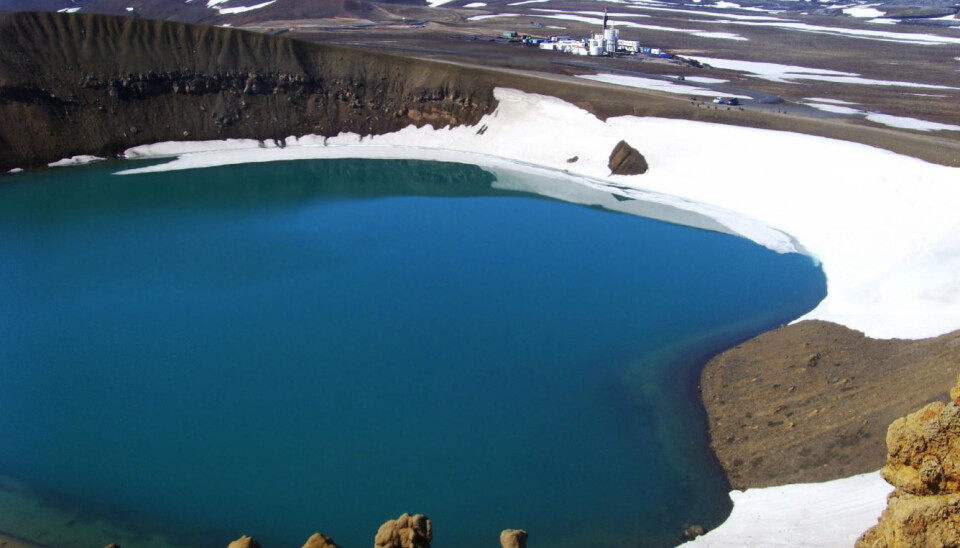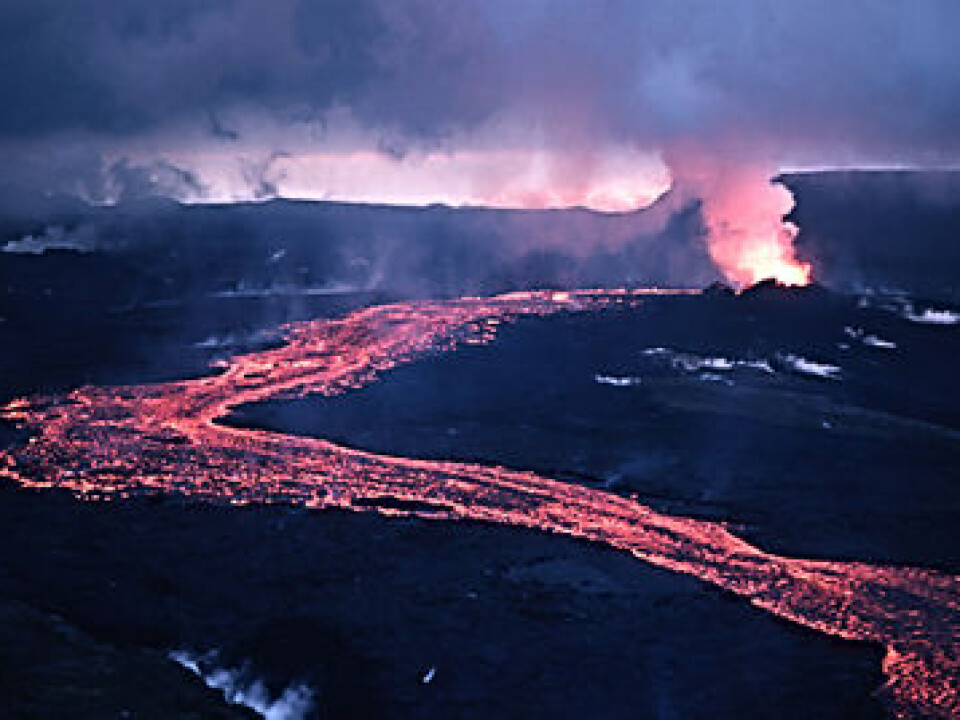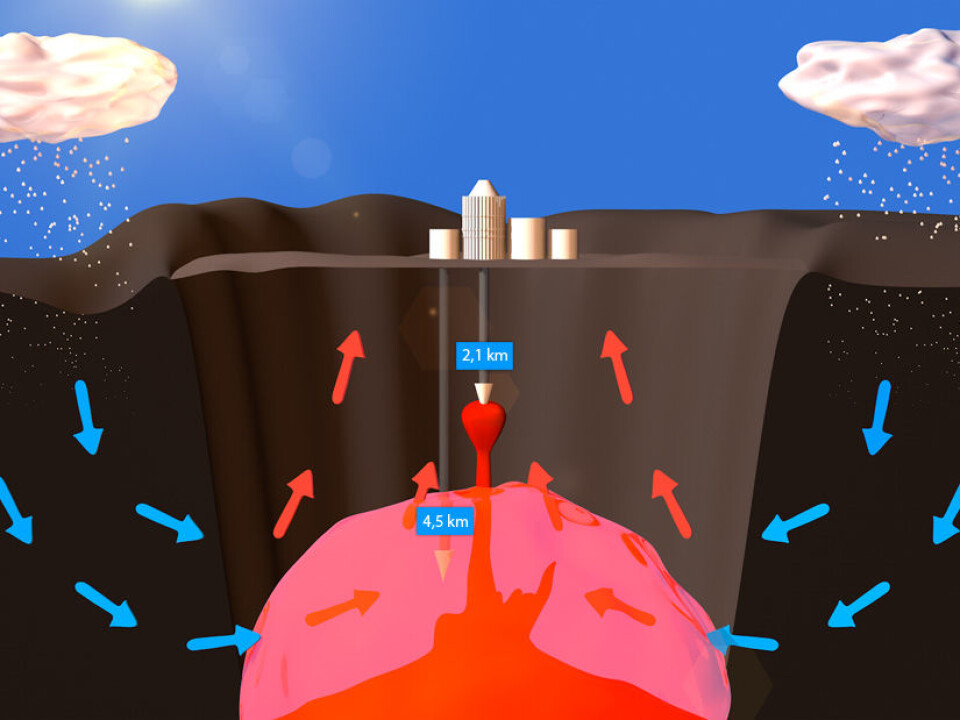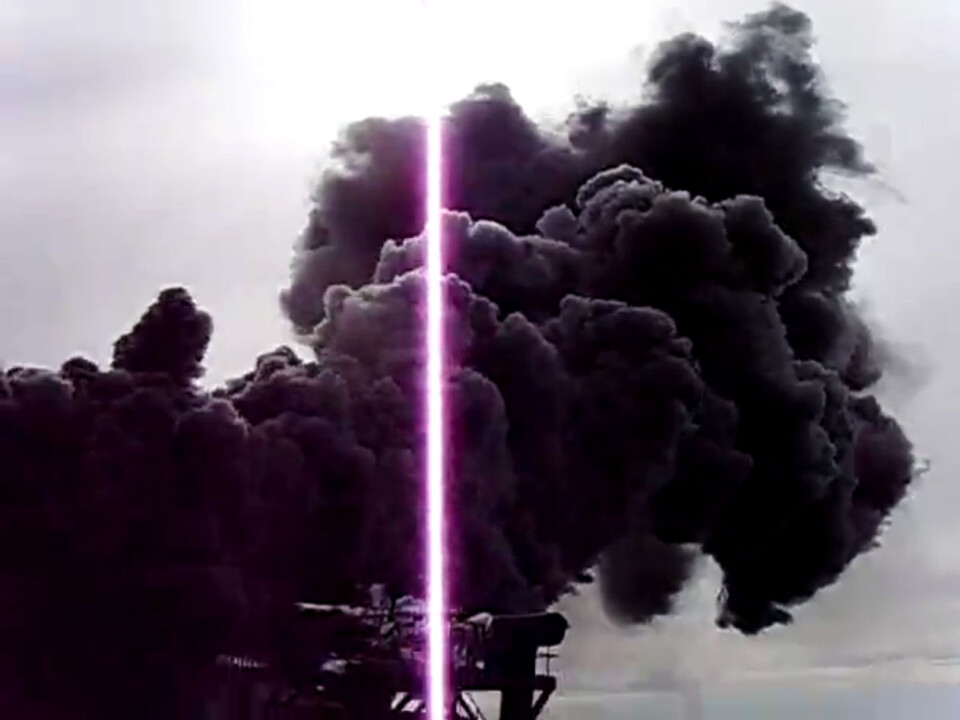
Drawing heat from hell
Water near glowing magma is so hot and under such high pressure that it has ten times the energy of normal geothermal sources. Can the Icelanders make use of this heat from the underworld?
Krafla is in the north of Iceland. This dip in the landscape is a caldera ten kilometres wide – a geological feature like a cauldron, created when the core of a volcano collapsed in the distant past.
The crater Víti is inside Krafla. Víti means “Hell” in Icelandic. In 1724 this crater erupted.
Icelandic scientists have drilled a two-kilometre deep well into the crater to judge opportunities for utilising this deep geo-energy.
“This is the hottest production well in the world, with a temperature of 450° C and a pressure of 140 bars, in other words about 140 times that of normal air pressure at sea level,” says Guðmundur Ómar Friðleifsson, who heads the project.

Krafla fights back
The power company Landsvirkjun started test drilling at Krafla back in 1974. The idea was to build a geothermal power plant.
But Krafla wasn’t cooperative. Glowing molten sores popped up where the Earth’s crust stretched and fractured, just two kilometres from the drill strings. Eruptions in the 1970s and ‘80s threatened the entire project.
The cause of this mayhem is the slow drift of continental plates. The Eurasian plate in the east and the North American in the west are moving apart. This tectonic tearing process is what put Iceland on the map, literally, and it runs right through Iceland and Krafla. The rift bleeds magma.

Drilling continued despite the eruptions. In 1978 the Icelanders won their battle with Krafla. Landsvirkjun’s geothermal power plant produced its first megawatt. In 1984 Krafla became less volcanically active once again.
But she’s a light sleeper. Nevertheless, geologists aren’t exactly tiptoeing around her: New drill strings are snaking their way toward the real heat of this hell.
Something more is going on in the depths. A magma chamber is developing. Sometime in the future it will burst into a new volcanic eruption.
Superheated water

The Icelanders are trying a novel and bold technology before the next eruption occurs. They are drilling as close to the magma chamber as they can. Here they will extract from five to ten times the energy they currently get from the drill holes that serve the power plant.
In the vicinity of the magma, ground water is so hot and compressed that it is no longer a mixture of water and steam, but rather a superheated dry steam. This superheated steam can liberate more energy than normal steam driving the turbines that convert it into electricity.
Thorough preparations after some failures
The Iceland Deep Drilling Project (IDDP) was started twelve years ago. Scientists from all over the world participated in the first meeting in Reykjavik. Iceland was a particularly promising country because the supercritical water here is especially highly energised.

Following a failed attempt at drilling deep further from the volcano, IDDP decided to drill right at Krafla, but not without making thorough preparations.
The local rock structure was mapped as accurately as possible. Measurements of electrical and magnetic fields showed how the different rock strata conducted electricity. Small tremors were registered on the surface.
These assessments were combined to give a clearer subterranean picture, including the structure of the magma chamber. IDDP decided to drill on the north end of the area where the geothermal plant was located.
Stopped just in time
Drilling of the well dubbed IDDP-1 started in March 2009. Iceland was then in the midst of its worst ever economic crisis but work continued nevertheless.
Initially everything went according to plan. Then the troubles started. The drill string got stuck and was twisted off. New holes had to be drilled next to the old one. Delays ran into weeks.
Nor could the engineers drill the first and widest well down to 2,400 metres as planned. They decided to call it quits at a depth of 1,958 metres. This proved fortunate because soon all their problems were clear – as glass.
Glass stopper
The last rock they’d reached was solidified natural glass, obsidian. The engineers had drilled right into a pocket of melted rock – into magma.
Geologists calculated the thickness of this pocket at 50 metres or more in order to have remained in a molten state inside the cooler rock ever since the magma chamber formed in the 1970s and ‘80s.
The obsidian created a 20-metre glass stopper in the bottom of drill hole IDDP-1. The engineers pumped cold water into the hole and the rock heated it up for months. This allowed them to appraise the heat flow.
Hottest well in the world
More gauging of the temperatures was conducted in 2010 and 2011.
“We are still measuring the heat conduction from the well,” says Friðleifsson, who has managed IDDP since the beginning of 2000.
Even though IDDP-1 is the hottest production well on the planet and the water is superheated, it has less pressure and heat than the scientists and engineers behind the IDDP originally hoped to reach beneath Krafla.
Friðleifsson is optimistic, however.
“The well IDDP-1 will produce from 25 to 35 megawatts. This is about half of what the entire rest of the Krafla power plant currently generates. Landsvirkjun is now planning to use steam from this well in power production by year’s end,” says Friðleifsson.
Several wells at a time
While assessing heat flow, IDDP is evolving methods of ridding the superheated water of sulphur, hydrochloric acid and other substances that corrode or clog the pipes.
“If insufficient ground water is found to continue producing superheated water, other water can be pumped in. The systems needed for doing this have already been developed for conventional geothermal plants,” explains Friðleifsson.
After the first well is completed, IDDP plans to go back to its point of departure. It projects drilling its next well at Reykjanes in 2013 or 2014.
“We aren’t the only ones exploring these new resources,” stresses Friðleifsson. “Japan is starting to drill deep again, as are New Zealand, Italy and the USA. They all want to exploit deep geo-energy and we are all cooperating with one another,” he says.
------------------------------
Read this article in Norwegian at forskning.no
Translated by: Glenn Ostling





